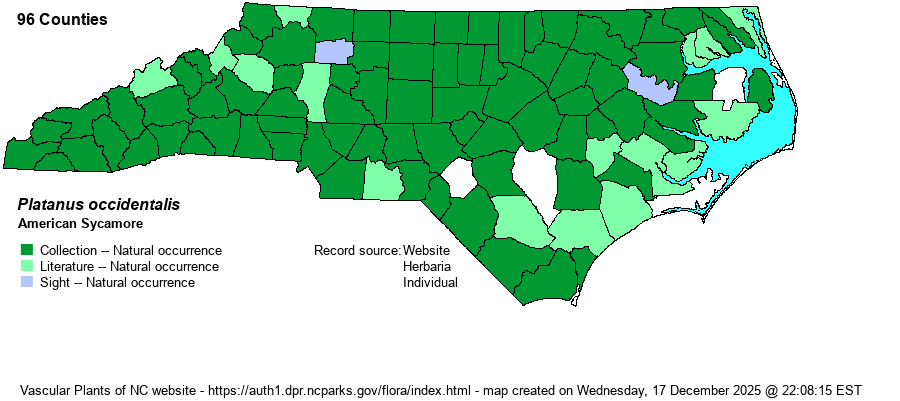| Section 6 » Order Hamamelidales » Family Platanaceae |
Show/Hide Synonym
| taxonName | relationship | relatedTaxonName | relatedTaxonRefText | relComments |
|---|
|
|
|
| Platanus occidentalis | = | Platanus occidentalis var. occidentalis | Kubitzki in Kubitzki, Rohwer, & Bittrich (1993). | | | Platanus occidentalis | < | Platanus occidentalis | Gleason and Cronquist (1991) | | | Platanus occidentalis | < | Platanus occidentalis | Flora of North America (1993b, 1997, 2000, 2002a, 2002b, 2003a, 2004b, 2005, 2006a, 2006b, 2006c, 2007a, 2009, 2010) | | | Platanus occidentalis | < | Platanus occidentalis | Gleason (1952) | | | Platanus occidentalis | < | Platanus occidentalis | Godfrey and Wooten (1979, 1981) | | | Platanus occidentalis | < | Platanus occidentalis | Kartesz (1999) | | | Platanus occidentalis | < | Platanus occidentalis | | | | Platanus occidentalis | < | Platanus occidentalis | Radford, Ahles, and Bell (1968) | | | Platanus occidentalis | < | Platanus occidentalis | Small (1933, 1938) | | | Platanus occidentalis | < | Platanus occidentalis | | | | Platanus occidentalis | < | Platanus occidentalis | Wofford (1989) | | | Platanus occidentalis | < | Platanus occidentalis | Wunderlin & Hansen Flora of Florida (3) | | | Platanus occidentalis | < | Platanus occidentalis | Flora of West Virginia | | | Platanus occidentalis | > | Platanus occidentalis var. occidentalis | Fernald (1950) | | | Platanus occidentalis | > | Platanus occidentalis var. glabrata | Fernald (1950) | | | Source: Weakley's Flora |
|
| Author | L. | |
| Distribution | Occurs statewide, and might be present in all 100 counties. However, of sparse distribution in the far eastern part of the Coastal Plain.
This is a wide-ranging Eastern species, occurring from southern Canada south sparingly into FL and to central TX.
| |
| Abundance | Common to very common across the Mountains and Piedmont, easily seen every day. It is fairly common to common in parts of the western Coastal Plain, such as along the Roanoke and Cape Fear rivers. However, it is uncommon in the Sandhills and most of the eastern two-thirds of the Coastal Plain. It is rare to uncommon in the far eastern counties (absent in Carteret and Hyde?). | |
| Habitat | This is a wetland species seldom far from water, growing most often along stream and river banks, but also is present in floodplains, and in drier swamps. It grows well in clearcut wetlands, where it is somewhat of a pioneer woody species of brownwater wetlands. American Sycamore is also planted as an ornamental (historically at least), and a number of county records may pertain to local escapes to roadsides and field borders rather than to natural wetlands. |
| Phenology | Flowers from April to June, and fruits from September to November. | |
| Identification | This large and stately deciduous tree needs little introduction. It often grows to 100 feet or more, but it is better known for its large trunk and widely spreading crown, with strong branches. The bark alone easily identifies it, at all seasons. The trunk is usually a patchwork of gray plates and white inner bark, such that the highly mottled bark coloration is easily visible even from a moving vehicle. The leaves are very large and palmate, being about 6 inches long, and often wider than long; there are several strong teeth as well. They may look like a very large maple leaf to some folks. In addition, the fruit is a unique rounded “ball” about 1.5 inches across, hanging downward on a slender stalk several inches long. Thus, anyone, even the general public, should be able to recognize this tree at a quick glance at any time. | |
| Taxonomic Comments | Some references list varieties for it, though Weakley (2018) and NatureServe do not.
| |
| Other Common Name(s) | Plane-tree. As this is the only sycamore species in the Eastern states, it is often simply written with just the single word – Sycamore. | |
| State Rank | S5 | |
| Global Rank | G5 | |
| State Status | | |
| US Status | | |
| USACE-agcp | FACW link |
| USACE-emp | FACW link |

